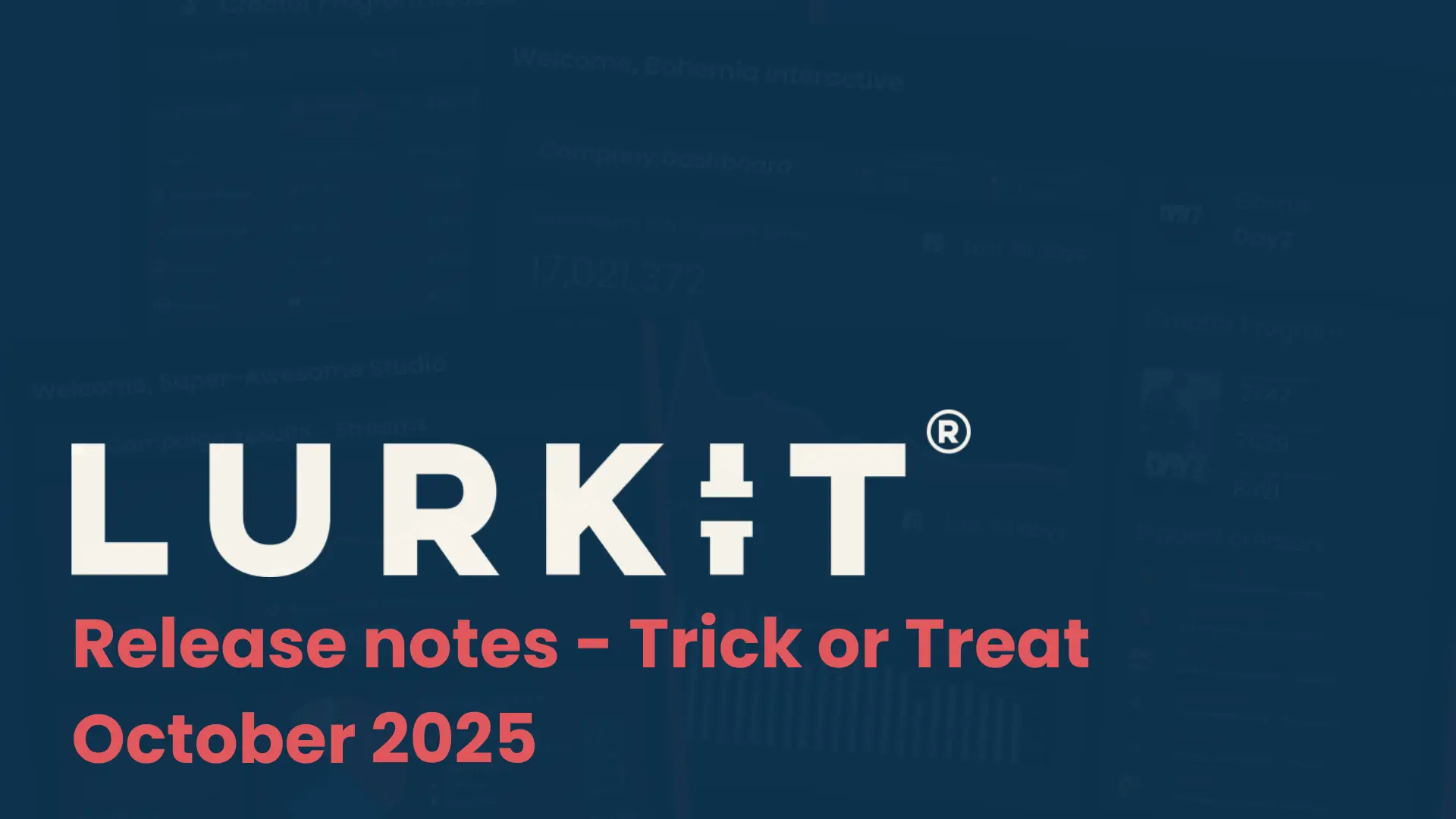Most important metrics to look at when analyzing your influencer campaign
Influencer marketing is one of the best, if not the best, ways of getting your product out to Gen Z and gamers. Many studies have proved it to be incredibly effective, and even as new as it is, influencer marketing is already an $8 Billion industry.
There are a ton of intricacies that go into an influencer marketing campaign, from making your product attractive to influencers to finding the right content creator and choosing the correct marketing strategy. It’s always going to be a lot of work and take a while to see some results, but influencer marketing has proven to be very successful.
If you’re thinking about running an influencer marketing campaign, or have run one already, you’ll need to consider all the above, but, more importantly, you’ll need to know how to analyze your campaign.
From impressions to followers, traffic, reactions, views, likes, and engagement, there’s a very wide variety of metrics to consider. These are generally known as key performance indicators (KPIs for short), and give you insight into exactly how your campaign went.
You’ll need to know which metrics to keep an eye on, and which ones should be your main focus. There are quite a few so let’s break them down one by one and talk about why they matter.
Reach
Your campaign reach is the first thing to look at. Simply put, this includes a variety of metrics that indicates how many people saw your campaign. It’s a good indicator of the popularity of your campaign but doesn’t directly translate into how many people it actually affected, and, most importantly, sales.
Some of the most important metrics to keep in mind are: impressions, stream stats, and CPM.
Impressions
Impressions are the bread and butter of viewership in an influencer campaign. This mostly applies to social media, showing the total number of times a post was viewed. Keep in mind this includes multiple views, so it may be a bit inflated from people viewing a post multiple times.
You can easily dig this stat up from individual posts, and on websites like Twitter and Instagram, it only really takes a second. Although, if an influencer is making posts directly, you’ll need them to provide this number.

Stream stats
Much like impressions, stream stats are essentially a way to see how many people viewed your campaign, but specifically during a stream. These come in quite a few forms, but the most important ones are total views and concurrent views.
Total views are, quite simply, the total amount of viewers that saw the stream, basically like impressions but for streams. Meanwhile, concurrent views is how many people, on average, were watching the stream. This stat is more of a general indicator of how popular your campaign was with the streamer’s audience, but still good to keep in mind.
CPM
CPM, or Cost Per Thousand, is the traditional way of measuring the cost of a number of impressions. This is a vital metric to keep in mind, as it shows, in essence, how cost-effective your campaign was.
You can also use it for stream viewership and it is very easy to understand. It will not only give you an idea of how much you spent per thousand views or impressions, but also give you insight into how much influencer marketing could cost going forward.
You can compare it with other campaigns and even other streamers to see the effectiveness of each, and then decide what types of campaigns to run in the future and which streamers to use. Of course, don’t forget to consider all the other metrics too!
To calculate CPM follow this formula: Total Cost x 1000 / Total Impressions
Engagement
While reach is the base metric that you should be looking at and quite important overall, engagement can be thought of as a more in-depth version of it. Engagement is a way to measure how many people interacted with your campaign.
While it’s good that many people see your campaign and hear of you, engagement, followed by sales or another end target, is where you can really see the effectiveness of the campaign.
There are quite a few things to consider here and while they are straightforward, some in-depth details are key. Let’s break them down below:
Likes and shares
Likes and shares only apply to social media and are a good indication of how popular a post is, with more of each making the post more visible. Social media is a huge part of an influencer campaign, so keeping tabs on the number of likes and shares is vital.
These directly influence how popular a post will be on social media, and with enough of them, a post may even become trending and grow in popularity exponentially.
Comments
Similarly to likes and shares, comments mostly apply to social media, but they can also apply to influencers on YouTube, depending on the content.
Mostly, comments can be viewed as a way of feedback, as users can write anything they want. However, if a certain video or social media post has vastly more comments than others, it can point to something being done right or wrong, depending on the comments. Therefore, you could use that as a base of what to do or not do.
Clicks
Clicks are one of the most important metrics to look at. What clicks show is how many viewers actually took enough interest in the campaign to click on however it was being advertised, be it social media, videos, or streams.
There are a few different types of clicks. On social media, it can be either someone looking at the post in detail or following the link, while on YouTube or streams, it needs to be measured differently.
You should have used affiliate links in your campaign, in order to really narrow down how many new website users came from influencers, and from which influencer. If you’re unfamiliar with affiliate links, simply put, they are a link specifically created for individuals to share, making it easy to track how many users follow that link. If you want to learn more about affiliate links and how to integrate them into your marketing campaign, check out our affiliate guide.
These links can then be used to see exactly how many people entered your website from each influencer, making it very simple to separate your usual traffic from new traffic generated by the influencers.
CPI
Cost Per Interaction (or CPI) is another vital metric to keep in mind. Much like with CPM, this is used to track the cost-effectiveness of your campaign, this time targeting the cost per interaction, which in our case can be any of the metrics of engagement.
Once again, you can use it to see just how much you got (in terms of engagement) for the amount you put in and can then compare it to other campaigns and individual influencers to get an idea of what you should and shouldn't do again.
To calculate CPI follow this formula: Total Cost / Total Interactions
Sales
Of course, we can't talk about the effectiveness of a marketing campaign without mentioning sales.
Before we go into it, it’s vital to keep this in mind: measuring sales in influencer marketing is very difficult, and it’ll never be an exact number.
Much like with any other type of marketing, you can get an idea of how well it did through the sales, but you’ll never really know how many people were persuaded by your marketing strategy.
However, there are some ways to track this, and as such get a solid idea at the very least. Two ways are very popular, using affiliate links, or giving influencers custom discount codes.
Affiliate links are unique links given out to influencers to track just how many people come through the link they share. They have already been discussed, so be sure to check out the clicks section for a further explanation.
Meanwhile, you can also give out custom discount codes to influencers. This makes it very easy to track how many sales the influencer generated, as their viewers will enter their unique code when making a purchase. Although, some viewers may forget to use it or purchase the product somewhere else, so it won’t be exact.
Regardless, you can use these methods to somewhat effectively track sales and most importantly help tie them to a specific influencer to give you an idea of what’s working and what isn’t.
These are the main metrics you’ll need to consider when analyzing your influencer marketing campaign. Make sure to keep each one in mind, as no matter how important or unimportant they may seem, they’re all very useful to know.
However, this doesn’t mean you shouldn’t have a special preference for certain metrics. One influencer may only generate a small amount of reach, but if their audience has a large engagement percentage, they’re doing a very good job.
When it comes down to it, you’ll want to strike a good balance, and always take the stats with at least a grain of salt. As you know, it’s very difficult to calculate exact figures with almost any type of marketing.








